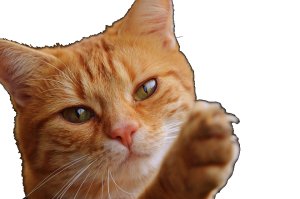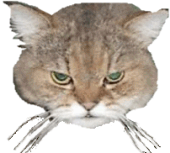

 | knowyourcat.info |

This is the second part of our investigations into what your cat is trying to tell you, and why you should watch rather than listen to what your cat has to say.
Tail
The important thing to remember is that when the cat wags her tail, she is angry, not as some people think, pleased. This the the exact opposite to dogs. When a cat is pleased to see you she will put her tail straight up.
As the cat become more alert the tail goes down. So for example, the cat will walk tail up in the house in your company where all is well and safe, but out in the garden the tail will drop to the neutral position. This could be more or less level with her back or further down, but straight, which indicates a neutral to a slightly aggressive posture.
As the cat becomes more aggressive her tail will be facing down but with a definite kink at the base. You can often observe this shape when the cat is chasing after something. We have already mentioned the tail slashing backwards and forwards. That is a warning to back off and more vigorous the slashing, more excited and aggressive the cat is.
A 'bottle-brush' tail - tail up and bushy - indicates an angry, emotionally charged cat. You will often see it after argument with the cat next door. Very often the cat's coat on the back will also be standing up. The message is clear - I want to seem much bigger than I am.
When the cat lies on her side or is sitting down and the tail twitches slightly it normally means 'I am interested, ready to play'.
Eyes

Eyes are another organ which cats use for communication. Cats with eyes fully open and looking straight at you want to say "I am listening". Half closed eyes means 'I am sleepy and content'. A cat's eyes are very big, and the pupils can expand to take up almost the entire area of the eye.
This is useful for night vision, allowing the cat to absorb the maximum amount of existing light. When there is plenty of light, the cats pupils will narrow to a slit.
But as soon as the cat becomes uneasy, its pupils will expand to allow it to take in more of its surroundings. However, a cat's pupils will also expand when she is excited, so for example the excitement of seeing her people after their absence will result in dilated eyes.
The important thing to remember on the subject of eyes is that cats regard eye contact as aggressive. So two rival cats will try to out-stare each other to resolve the conflict. Staring directly into cats eyes will always be interpreted as an aggressive behavior. Have you ever wondered why, when there is a group of people and the cat wanders in, it will choose to sit on the lap of the only person who does not like cats?
The answer is very simple. Most people when they see a cat, look at her, and try to pet her to show her how much she is liked. But the effect on the cat is the opposite: the cat thinks, 'Why is this person so aggressive towards me?' and then chooses the company of the one person who offers no threat.
The other interesting thing is cat's communication through blinking. Try doing an experiment. Sit next to your cat when she is fully relaxed, and then slowly close and open your eyes. Watch the cat doing the same. What you have both said is 'Hi, I like you'.
Head

Angry - ears and whiskers back, eyes narrow, pupils wide
We have already covered some aspects of head movement, but I will iterate briefly here. A cat holding her head up is a content and confident cat. At the sight of danger the head goes down. When the cat wants to a show lack of interest or say 'I am not aggressive' it will turn its head sideways. But there are other important ways the cat communicates with you.
When you stroke your cat she will raise her head up to expose the area of the neck where she wants to be stroked. This is one of the areas of cat's body where pheromones are present. By stroking a cat under her chin you transfer some of the pheromones on your hands. The pheromones are also present in the cheek pouches, and again by rubbing herself against you the cat transfers her pheromones on you. This is an affectionate gesture to indicate that you are her friend.
The same applies when the cat raises her rear while being stroked. This is another of gesture which means 'I want to be your friend'. What the cat expects you to do is to smell it -again the principle is the same - there are pheromones around cat's anal glands. Of course, our sensitivities mean we do not take up this friendly offer, but from the cat's point of view, we are just being stand-offish.
Head butting is another way to show friendship. When you look at friendly cats from the same household you will see that they will often touch noses or gently butt heads. When the cat feels friendly towards you she will try to do the same (for example when you are putting food in her bowl!).
Paws
Cats which are relaxed will always retract their claws, when getting ready to a fight they extend them. A swiping movement of the paws indicates a battle-ready state and that fur will fly.
When a cat feels happy she will often start treadling with her paws as if kneading dough. This is a very kitten-like behavior. When the kitten feeds on her mother's breast she will knead to stimulate the milk flow. So kneading is always associated with pleasure. Happy cats may start kneading your tummy (sometimes forgetting that, unlike infant kittens, mature cats have well-developed claws!) or go off to their favourite blanket and knead.
 |

